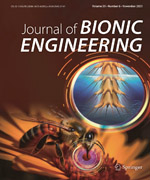
Journal of Bionic Engineering
ISSN 1672-6529
CN 22-1355/TB
Editor-in-Chief : Luquan Ren Published by Science Press and Springer
Online Journal
Most Down Articles
| Published in last 1 year | In last 2 years| In last 3 years| All| Most Downloaded in Recent Month | Most Downloaded in Recent Year| |
| In last 3 years |
Please wait a minute...
|
|||||||


